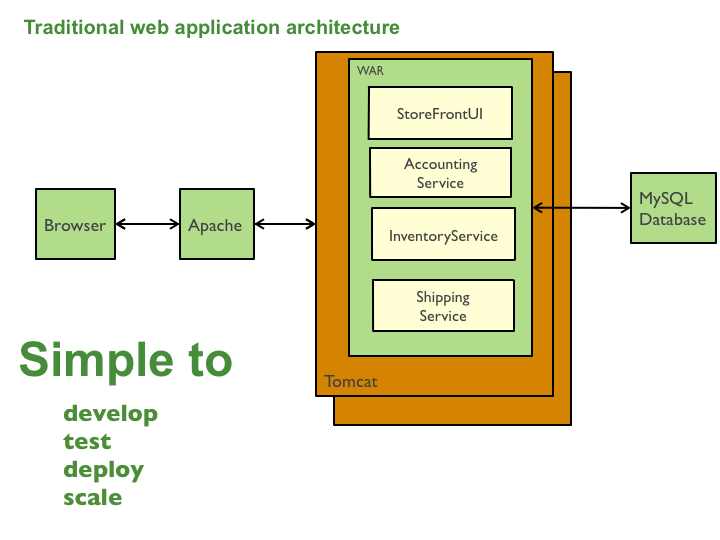In the world of software development, architecture is the blueprint that dictates the structure, scalability, and maintainability of an application. For decades, the Java ecosystem has been at the forefront of enterprise software, evolving from monolithic structures to highly distributed, cloud-native systems. Understanding modern Java Architecture is no longer just an advantage—it’s a necessity for building robust, high-performance applications that can stand the test of time.
This deep-dive article will guide you through the fundamental principles and advanced concepts of Java architecture. We’ll explore the classic layered approach, build a practical application using Java Spring Boot, transition to the world of Java Microservices, and cover essential best practices for performance and optimization. Whether you’re a junior developer looking to grasp the basics or a seasoned professional aiming to stay current with technologies like Java 17 and Java 21, this guide provides the foundational knowledge and practical code examples you need to design and build software that scales.
The Foundations: Layering and Design Patterns in Java
Before diving into complex frameworks, it’s crucial to understand the foundational principles that govern good software design. A well-structured architecture separates concerns, promotes reusability, and makes the system easier to test and maintain. The layered architecture and core design patterns are the bedrock of modern Java Development.
The Classic Layered (N-Tier) Architecture
The most common architectural pattern in Java Enterprise applications is the layered, or N-Tier, architecture. This pattern separates the application into distinct logical layers, where each layer has a specific responsibility and only communicates with the layer directly below it. A typical three-tier structure includes:
- Presentation/API Layer: This is the top layer responsible for handling user interaction or API requests. In modern Java Web Development, this is often a set of REST endpoints built using frameworks like Spring MVC or JAX-RS in Jakarta EE.
- Business/Service Layer: This layer contains the core business logic. It orchestrates operations, enforces business rules, and coordinates transactions. It acts as a bridge between the API layer and the data access layer.
- Data Access Layer (DAL): This layer is responsible for data persistence. It handles all communication with the database, abstracting the complexities of data storage and retrieval. Technologies like JDBC, JPA, and Hibernate are staples here.
This separation of concerns is a cornerstone of Clean Code Java, as it makes each part of the application independent and easier to manage.
Dependency Injection: The Glue of Modern Java
While many Java Design Patterns are important, Dependency Injection (DI) is fundamental to modern frameworks. Instead of creating its own dependencies, an object receives them from an external source (an “injector”). This inverts the control of dependency management, leading to loosely coupled components. The Java Spring framework is built around this principle.
Let’s illustrate this with a simple code example demonstrating the service and repository layers using interfaces for loose coupling.
// Data Access Layer Interface
public interface UserRepository {
User findById(Long id);
User save(User user);
}
// Business Logic Layer Interface
public interface UserService {
User getUserDetails(Long id);
User registerUser(String name, String email);
}
// Business Logic Implementation
// Note: @Service and @Autowired are Spring annotations for DI
@Service
public class UserServiceImpl implements UserService {
private final UserRepository userRepository;
// Dependency is injected via the constructor
@Autowired
public UserServiceImpl(UserRepository userRepository) {
this.userRepository = userRepository;
}
@Override
public User getUserDetails(Long id) {
// Business logic can be added here
return userRepository.findById(id);
}
@Override
public User registerUser(String name, String email) {
if (name == null || email == null) {
throw new IllegalArgumentException("Name and email cannot be null");
}
User newUser = new User(name, email);
return userRepository.save(newUser);
}
}Building a Modern Java REST API with Spring Boot
Spring Boot has become the de facto standard for building modern Java Backend applications, especially REST APIs and microservices. It simplifies the setup and development process by providing auto-configuration, embedded servers, and production-ready features out of the box. Let’s build upon our layered architecture concept to create a functional Java REST API.

The API Layer: Crafting REST Controllers
In Spring Boot, the API layer is implemented using controllers annotated with @RestController. These classes handle incoming HTTP requests, process them (often by calling a service), and return a response, which is automatically serialized to JSON.
Here’s an example of a UserController that exposes endpoints for fetching and creating users. It uses the UserService we defined earlier, which is injected via the constructor.
import org.springframework.beans.factory.annotation.Autowired;
import org.springframework.http.ResponseEntity;
import org.springframework.web.bind.annotation.*;
@RestController
@RequestMapping("/api/users")
public class UserController {
private final UserService userService;
@Autowired
public UserController(UserService userService) {
this.userService = userService;
}
@GetMapping("/{id}")
public ResponseEntity<User> getUserById(@PathVariable Long id) {
User user = userService.getUserDetails(id);
if (user != null) {
return ResponseEntity.ok(user);
}
return ResponseEntity.notFound().build();
}
@PostMapping("/")
public ResponseEntity<User> createUser(@RequestBody CreateUserRequest request) {
User newUser = userService.registerUser(request.getName(), request.getEmail());
return ResponseEntity.status(201).body(newUser);
}
}
// A simple DTO (Data Transfer Object) for the request body
class CreateUserRequest {
private String name;
private String email;
// Getters and setters omitted for brevity
}The Data Layer with Spring Data JPA
Spring Data JPA further simplifies the data access layer. By simply defining a repository interface that extends JpaRepository, we get a full set of CRUD (Create, Read, Update, Delete) methods for free. Spring uses Hibernate as the default JPA provider to implement these methods at runtime.
Here is what the repository for our User entity would look like. Notice how little code we have to write.
import org.springframework.data.jpa.repository.JpaRepository;
import org.springframework.stereotype.Repository;
// The User entity class
@Entity
public class User {
@Id
@GeneratedValue(strategy = GenerationType.IDENTITY)
private Long id;
private String name;
private String email;
// Constructors, getters, and setters omitted
}
// The Spring Data JPA repository interface
@Repository
public interface UserRepository extends JpaRepository<User, Long> {
// Spring Data JPA will automatically implement this method
// based on the method name.
Optional<User> findByEmail(String email);
}This combination of Spring Boot, Spring MVC, and Spring Data JPA provides a powerful and efficient stack for building robust, database-driven Java Web Development projects.
Advanced Architecture: Java Microservices and Asynchronous Patterns
While a layered monolith is suitable for many applications, systems with high scalability and agility requirements often benefit from a Java Microservices architecture. This approach structures an application as a collection of loosely coupled, independently deployable services.
From Monolith to Microservices
In a microservices architecture, each service is responsible for a specific business capability. For example, an e-commerce application might have separate services for user management, product catalog, inventory, and payments. This offers several advantages:
- Scalability: Each service can be scaled independently. If the product catalog gets a lot of traffic, you can scale just that service without touching others.
- Technology Freedom: Teams can choose the best technology stack for their specific service. One service might use Java 17 with Spring Boot, while another might use Kotlin or even Python.
- Resilience: The failure of one service doesn’t necessarily bring down the entire application.
However, this architecture introduces new challenges, such as service discovery, distributed data management, and inter-service communication. The Java Spring ecosystem offers solutions like Spring Cloud to address these complexities. For deployment, containerization with Docker Java and orchestration with Kubernetes Java are standard practices in the Java DevOps world.
Asynchronous Processing with CompletableFuture

In a distributed system, synchronous, blocking calls between services can create bottlenecks. Java Async programming is essential for building responsive and efficient systems. Since Java 8, CompletableFuture has provided a powerful way to write non-blocking, asynchronous code.
Imagine a scenario where you need to fetch user details from one service and their order history from another. Instead of doing this sequentially, you can do it in parallel.
import java.util.concurrent.CompletableFuture;
import java.util.concurrent.ExecutorService;
import java.util.concurrent.Executors;
@Service
public class UserAggregationService {
private final UserServiceClient userServiceClient;
private final OrderServiceClient orderServiceClient;
private final ExecutorService customExecutor = Executors.newFixedThreadPool(10);
// Assume clients for making HTTP calls to other services
// are injected here.
public CompletableFuture<UserAggregate> getUserData(Long userId) {
// Asynchronously fetch user details
CompletableFuture<User> userFuture = CompletableFuture.supplyAsync(() ->
userServiceClient.fetchUserDetails(userId), customExecutor
);
// Asynchronously fetch order history
CompletableFuture<List<Order>> ordersFuture = CompletableFuture.supplyAsync(() ->
orderServiceClient.fetchOrdersForUser(userId), customExecutor
);
// Combine the results when both futures complete
return userFuture.thenCombine(ordersFuture, (user, orders) -> {
// Create an aggregated response object
return new UserAggregate(user, orders);
});
}
}This example demonstrates how to leverage Java Concurrency to improve performance by running independent tasks in parallel. This pattern is crucial for building high-throughput microservices.
Best Practices for Performance and Optimization
A great architecture is not just about structure; it’s also about building a system that is performant, secure, and maintainable. Adhering to best practices is key to achieving these goals.
Clean Code and Testing
Writing Clean Code Java is paramount. This means using clear naming conventions, keeping methods small and focused, and following principles like SOLID. A clean codebase is easier to understand, debug, and extend.
A comprehensive testing strategy is non-negotiable. Use JUnit for unit tests to verify individual components in isolation. Use frameworks like Mockito to mock dependencies, ensuring your tests are fast and reliable. Integration tests should then be used to verify that different parts of the system work together correctly. This robust testing culture is a pillar of a healthy CI/CD Java pipeline, managed with Java Build Tools like Java Maven or Java Gradle.

Java Performance and JVM Tuning
Performance is a feature. In Java, this often involves understanding how the Java Virtual Machine (JVM) works. Key areas to consider include:
- Garbage Collection (GC): Modern Java versions (like Java 17 and Java 21) feature highly efficient garbage collectors like G1 and ZGC. Understanding their characteristics can help you tune the JVM for lower latency or higher throughput.
- JVM Tuning: Basic JVM flags like
-Xms(initial heap size) and-Xmx(maximum heap size) are a starting point. Profiling your application with tools like VisualVM or JProfiler can reveal bottlenecks and guide further optimization. - Efficient Code: Use the right data structures from the Java Collections framework. Leverage Java Streams and Java Lambda expressions for clean and sometimes more performant data processing. Be mindful of database queries and avoid common pitfalls like the N+1 select problem in Hibernate.
Security in Java
Security must be built into the architecture from day one. For a Java REST API, this means securing your endpoints. Use frameworks like Spring Security to handle Java Authentication and authorization. Implement standards like OAuth Java for delegated access and use JWT Java (JSON Web Tokens) for stateless, token-based authentication in microservices. Always validate and sanitize user input to prevent common vulnerabilities.
Conclusion: The Ever-Evolving Landscape of Java Architecture
We’ve journeyed from the foundational principles of layered architecture and design patterns to the practical implementation of a modern Java REST API with Spring Boot, and finally into the advanced realms of microservices and asynchronous programming. The key takeaway is that Java Architecture is not a one-size-fits-all solution. The choice between a monolith and microservices depends on your team’s size, the complexity of the domain, and your scalability requirements.
A successful Java architect continuously learns and adapts. The principles of clean code, separation of concerns, and robust testing remain constant, but the tools and patterns evolve. As you continue your journey, explore deploying your applications to the cloud using AWS Java or Google Cloud Java, dive deeper into the world of containerization with Docker and Kubernetes, and investigate other modern Java Frameworks like Quarkus and Micronaut. By building on this solid foundation, you’ll be well-equipped to design and develop the next generation of scalable, resilient, and high-performance Java applications.
